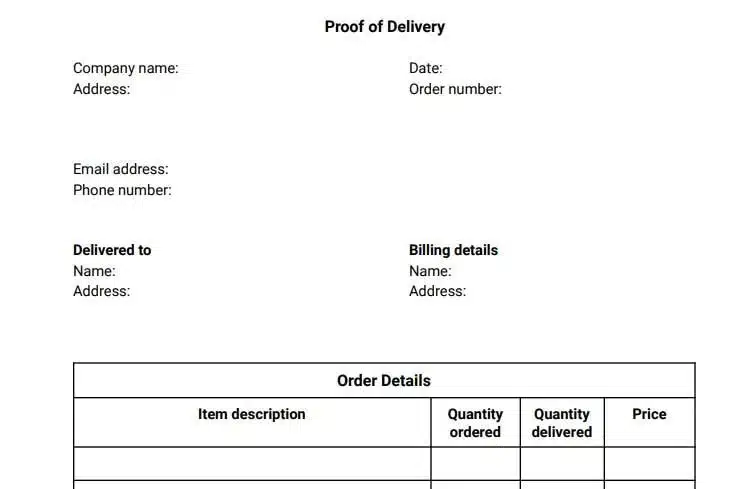Proof of Delivery (POD) is a fundamental concept in international trade and logistics. A clear and valid POD is essential for businesses, as it serves as a receipt confirming the completion of a shipment and acts as a legal document verifying that the goods have been successfully delivered to the intended recipient.
This article provides a detailed overview of POD—what it is, why it’s important, the different types, and best practices for using it effectively throughout the supply chain.

What is POD?
Proof of Delivery (POD) is an important part of the shipping process in international trade. It confirms that a shipment has reached its final destination and has been received by the right person. This proof usually comes as a signed document or digital confirmation showing that the recipient has accepted the goods. It helps ensure transparency and accountability between the shipper, carrier, and recipient.
Common POD Types
Proof of Delivery (POD) can take several forms, generally falling into two main categories:
1. Paper POD
This is the traditional method of confirming delivery. It usually involves physical shipping documents such as a copy of the Bill of Lading, Air Waybill, Delivery Note, or Receipt.
- The consignee or an authorized representative signs the document and records the date and time of receipt.
- In cases where goods are damaged or missing, these issues are typically noted directly on the document at the time of delivery.
2. Electronic POD (ePOD)
With advancements in technology, electronic PODs have become increasingly common. These digital systems capture delivery confirmation electronically and offer several added features:
- Digital Signature: The recipient signs on a handheld device like a smartphone or tablet.
- Photo Proof: For contactless deliveries, drivers may take photos showing where the goods were left as visual proof of delivery.
- GPS and Timestamp: The system automatically records the delivery time and location.
- Barcode/QR Code Scanning: To confirm receipt, packages are scanned upon delivery using barcodes or QR codes.
ePOD systems are faster, reduce the need for physical paperwork, and provide more detailed and traceable delivery data.

Key Elements of a POD Document
A well-prepared Proof of Delivery (POD) document typically includes the following essential details:
- Shipper Information
- Name and address of the company that shipped the goods.
- Consignee Information
- Name and exact delivery address of the recipient (company or individual).
- Carrier Information
- Name of the logistics or transportation provider responsible for the delivery.
- Shipment Details
- Unique tracking number or waybill number.
- Description of the goods (e.g., product name, quantity, weight, volume).
- Order number or reference number for internal tracking.
- Delivery Details
- Actual delivery date and time.
- Exact location of delivery (if different from the consignee’s listed address).
- Receipt Acknowledgment
- The recipient’s signature (or electronic signature in the case of ePOD) is required.
- The name of the recipient is printed in block letters.
- In some cases, a company stamp or seal may also be required.
- Condition Notes
- Any observations about the state of the goods upon delivery, such as “damaged packaging” or “item shortage.”These remarks are important and may serve as evidence in case of a delivery dispute or damage claim.
Why Proof of Delivery Is Important for Businesses
- Proof of Delivery (POD) is vital across the entire supply chain. It provides clarity, accountability, and operational efficiency for all parties involved. Here’s why it matters:
- Confirms Service Completion: For carriers, POD confirms that the transportation agreement has completed the delivery.
- Triggers Payment: For shippers (sellers), POD is often required to issue invoices and request Payment from customers. Without it, payments may be delayed or challenged.
- Helps Resolve Disputes: If the consignee claims they didn’t receive the goods, POD provides solid evidence to prove that delivery was made as agreed.
- Supports Claims for Loss or Damage: If items arrive damaged or go missing, a POD with detailed notes becomes essential for filing insurance claims or holding the responsible party accountable.
- Improves Inventory Management: Confirmed deliveries allow shippers to update inventory records and ensure correct stock levels.
- Enhances Customer Service: Clear and timely PODs build customer trust, reduce confusion, and improve overall satisfaction.
- Meets Legal and Contractual Requirements: In some industries or jurisdictions, maintaining PODs is necessary for compliance with legal or contractual obligations.

How to Use POD Correctly in Freight Forwarding Contracts
When drafting or signing a contract with a freight forwarder or carrier, it’s essential to clearly define how Proof of Delivery (POD) will be handled. The following terms should be explicitly included to ensure clarity and avoid disputes:
- POD Definition Requirements: Clearly outline what qualifies as a valid POD. Specify the required elements—such as shipment details, consignee signature, delivery date, and time—and whether electronic PODs (ePODs) are acceptable.
- Submission Deadline: Set a clear timeline for when the POD must be submitted after the delivery is completed (e.g., “within 24 hours of delivery”). This ensures timely invoicing and processing.
- Format and Submission Method: Define the acceptable format (e.g., scanned paper copy, original digital file) and the submission method (e.g., via email, document portal, or logistics system upload).
- Exception Handling Procedures: Establish how to document and report any issues noted upon delivery, such as damage or shortages, on the POD. Also, include the steps for investigating and resolving such claims.
- Consequences of Missing or Invalid POD: Clearly state the consequences if the carrier fails to provide a valid POD on time. This might include delayed freight payments, assumption of liability for missing goods, or penalties.
- Payment Terms Linked to POD: Tie freight payment terms directly to submitting a valid POD. For example:“Freight charges will be paid within XX days of receipt of a clear and valid POD.”
POD Best Practices
To manage and utilize Proof of Delivery (POD) effectively, businesses should implement the following best practices:
- Standardize Processes: Establish clear and consistent procedures for collecting, processing, and storing PODs across the organization.
- Train Personnel: Ensure that all relevant staff, especially drivers and warehouse teams, understand the importance of PODs and are trained on proper procedures, including handling exceptions or making notes about delivery issues.
- Adopt Electronic POD (ePOD): Whenever possible, transition to an ePOD system to benefit from faster processing, greater accuracy, real-time tracking, and richer data capture.
- Ensure Complete and Accurate Information: Verify that all key details—such as delivery time, consignee signature, item condition, and location—are clearly and accurately recorded on the POD.
- Timely Collection and Processing: Collect PODs from carriers as soon as delivery is completed and process them promptly to update systems, trigger billing, and close out delivery records.
- Secure Archiving: Store PODs—whether physical or digital—in a secure, organized, and easily accessible manner, following internal policies and legal retention requirements.
- Handle Exceptions Proactively: Develop a clear process for managing issues noted on PODs, such as damaged goods or shortages, and ensure timely follow-up and resolution.
- Conduct Regular Audits: Regularly review your POD processes to ensure they are followed correctly and comply with company standards and regulatory requirements.
In Summary:
POD is a critical element in international trade and logistics. It confirms delivery completion and plays a key role in protecting the rights of all parties, resolving disputes, and improving operational efficiency. As technology continues to evolve, electronic POD systems are making this process more streamlined, accurate, and transparent.



